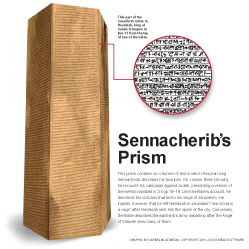29:1–32:33 The collective work of 1–2 Chronicles devotes more time to the reign of Hezekiah than any other king except David and Solomon. While 2 Kgs 18–20 covers Hezekiah’s conflict with Assyria, the account in 1–2 Chronicles focuses on his religious reforms. This fits with the Chronicler’s emphasis on proper temple worship (see note on 1 Chr 1:1–9:44). |
29:1 Hezekiah King of Judah circa 715–697 bc. Praised as one of the best rulers of Judah due to his devotion to Yahweh.
29:3 In the first year of his kingship Hezekiah started his reforms at the very beginning of his reign.
29:4 he brought in the priests and the Levites By assembling the priests and Levites, Hezekiah follows the leadership example of David (see 1 Chr 15:4; 23:3).
29:5 Sanctify yourselves now David makes a similar command as he prepares to move the ark to Jerusalem. See 1 Chr 15:12 and note.
bring out the defilement from the sanctuary Hezekiah’s father, Ahaz, apparently had used the temple and its materials for his idolatry.
29:7 They also shut the doors of the portico Hezekiah looks to reverse the actions of Ahaz (2 Chron 28:24–25; 2 Kgs 16:17–18).
29:8 And the wrath of Yahweh was Yahweh’s wrath on Judah during Ahaz’s time caused defeat by Israel (2 Chron 28:11) and led Judah to become a vassal of Assyria (28:16–21).
29:10 Now it is in my heart A similar Hebrew phrase is used to describe David’s intention to build the temple (1 Chr 22:7).
29:12–14 The Chronicler lists Levites according to the divisions established by David, with two representatives from each family. The first three families were part of David’s divisions of Levites (1 Chr 23:6–23); the final three were part of David’s divisions of temple musicians (1 Chr 25:1–7); the middle family—the descendants of Elizaphan—is mentioned in 1 Chr 15:8. |
29:13 Asaph Associated with many psalms. See Psa 73:title and note.
29:14 Heman Associated with Psa 88.
Jeduthun Associated with Pss 39; 62; 77.
29:15 because of the words of Yahweh The cleansing of the temple and the return to proper worship is linked with the reestablishment of a covenant between God and the Davidic king (2 Chron 29:10).
29:16 to the Wadi Kidron Located on the east side of Jerusalem; often used to dispose of idols (e.g., 2 Chron 15:16; 1 Kgs 15:13; 2 Kgs 23:6, 12).
29:17 on the first day of the first month The cleaning of the temple took 16 days.
the sixteenth day of the first month Two days after Passover (Num 9:2–3). Hezekiah waited until the temple was clean to celebrate Passover (2 Chron 30:1–3).
29:18 the altar of burnt offering As made by Solomon (see 4:19–22).
29:19 all the objects that King Ahaz discarded See 28:24.
29:20 gathered the officials of the city Just as David and Solomon had done when the ark of the covenant was moved (see 1:2 and note; 5:2 and note).
29:21 as a purification offering Intended to restore the sanctity of the temple, which had been contaminated by the people’s sins. Compare Lev 4:3 and note.
29:22 and threw it toward the altar See Lev 8:15 and note.
29:24 to make atonement Signifies forgiveness of sins. See Lev 4:20 and note.
all Israel This probably includes the northern kingdom, as well as Judah.
29:25 with cymbals, harps, and lyres The typical grouping of instruments for worship in Chronicles (2 Chron 5:12; 1 Chr 15:16; 25:1).
for worship in Chronicles (2 Chron 5:12; 1 Chr 15:16; 25:1).
Gad Prophet who advised David (1 Sam 22:5; 2 Sam 24:11–19: 1 Chr 21:9–19).
Nathan See 2 Sam 7:2 and note.
29:28 all the assembly bowed down The Chronicler emphasizes that the people were unified in their worship.
29:30 the words of David and Asaph A reference to the psalms, many of which name David and Asaph in the title.
So they offered praise with joy The Chronicler often emphasizes the joy associated with worship (1 Chr 12:40; 15:16; 29:9, 22; 2 Chr 15:15; 20:27; 30:21–26).
29:34 more conscientious The Hebrew phrase used here, yishrath levav, may be literally rendered as “upright in heart”; it also is used by Solomon to describe David (1 Kgs 3:6).

|
About Faithlife Study BibleFaithlife Study Bible (FSB) is your guide to the ancient world of the Old and New Testaments, with study notes and articles that draw from a wide range of academic research. FSB helps you learn how to think about interpretation methods and issues so that you can gain a deeper understanding of the text. |
| Copyright |
Copyright 2012 Logos Bible Software. |
| Support Info | fsb |
 Loading…
Loading…



